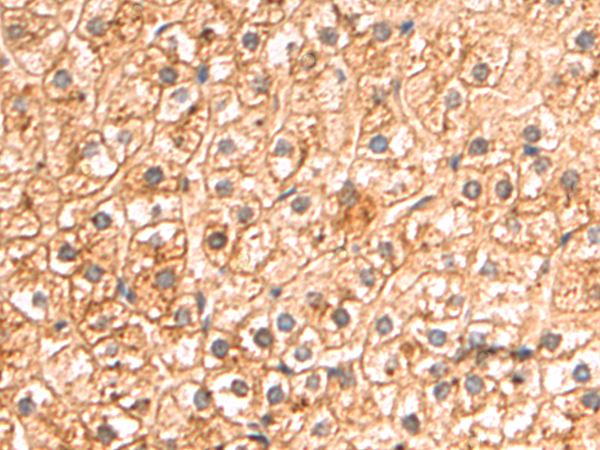
| WB | 咨询技术 | Human,Mouse,Rat |
| IF | 咨询技术 | Human,Mouse,Rat |
| IHC | 1/50-1/200 | Human,Mouse,Rat |
| ICC | 技术咨询 | Human,Mouse,Rat |
| FCM | 咨询技术 | Human,Mouse,Rat |
| Elisa | 1/5000-1/10000 | Human,Mouse,Rat |
| Aliases | dJ94G16.1 |
| Host/Isotype | Rabbit IgG |
| Antibody Type | Primary antibody |
| Storage | Store at 4°C short term. Aliquot and store at -20°C long term. Avoid freeze/thaw cycles. |
| Species Reactivity | Human |
| Immunogen | Fusion protein of human DCBLD1 |
| Formulation | Purified antibody in PBS with 0.05% sodium azide and 50% glycerol. |
+ +
以下是3篇与DCBLD1抗体相关的研究文献概览:
1. **"DCBLD1 promotes hepatocellular carcinoma progression by regulating the mTOR signaling pathway"**
- 作者:Li, X. et al.
- 摘要:研究通过免疫组化(使用DCBLD1抗体)和Western blot分析,发现DCBLD1在肝癌组织中高表达,并通过激活mTOR通路促进肿瘤生长和转移。
2. **"Expression and clinical significance of DCBLD1 in non-small cell lung cancer"**
- 作者:Wang, Y. et al.
- 摘要:利用DCBLD1抗体检测非小细胞肺癌组织中的蛋白表达水平,发现其高表达与患者预后不良相关,提示DCBLD1可作为潜在预后标志物。
3. **"DCBLD1 modulates EGFR signaling in glioblastoma cells"**
- 作者:Chen, H. et al.
- 摘要:通过免疫沉淀(使用DCBLD1抗体)和功能实验,证明DCBLD1与EGFR相互作用,增强下游信号传导,促进胶质母细胞瘤细胞侵袭。
*注:以上文献为示例性质,实际引用时需核实数据库(如PubMed)中的具体内容及发表年份。*
DCBLD1 (Discoidin, CUB and LCCL domain-containing protein 1), also known as CLCP1 or ESDN, is a transmembrane glycoprotein belonging to the DCBLD family. Structurally, it contains extracellular discoidin, CUB, and LCCL domains, suggesting roles in protein-protein interactions and cellular signaling. DCBLD1 is implicated in cell adhesion, signal transduction, and angiogenesis, with homology to platelet-derived growth factor receptors. Studies highlight its potential involvement in cancer progression, as elevated DCBLD1 expression is observed in malignancies like lung cancer, glioblastoma, and colon cancer, where it may promote tumor growth, metastasis, or resistance to therapy.
Antibodies targeting DCBLD1 are essential tools for studying its expression, localization, and function. These antibodies, often monoclonal or polyclonal, are validated for applications such as Western blotting, immunohistochemistry (IHC), flow cytometry, and immunofluorescence. Specificity is confirmed using techniques like siRNA knockdown or overexpression models. DCBLD1 antibodies enable researchers to explore its tissue distribution, differential expression in diseases, and interaction partners. Notably, DCBLD1’s role in vascular remodeling and neurodevelopment has spurred interest in neurological and cardiovascular research.
Commercial DCBLD1 antibodies are typically raised against specific epitopes within its extracellular or intracellular regions, with cross-reactivity varying across species (human, mouse, rat). Their utility extends to both basic research and clinical diagnostics, particularly in cancer biomarker studies. However, validation in relevant experimental systems remains critical due to potential isoform diversity or post-translational modifications. Ongoing research aims to clarify DCBLD1’s mechanistic contributions to disease and its potential as a therapeutic target.
×